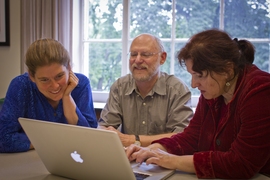Faced with this problem, a group of instructors in MIT’s Department of Mathematics decided that many heads are better than one. They began brainstorming ways to encourage teacher-to-teacher collaboration, bridging educators with similar challenges in different courses and from semester to semester. Now, they’ve developed a tool they believe will be useful to educators across academic fields, at MIT as well as other universities. The team calls the Web-based tool the Educational Collaboration Space (ECS), and it is available at ecs.mit.edu; download is free for everyone.
“There’s a lot of software about students communicating with each other and students communicating with their professor, but there’s not very much about building a community of educators,” says Haynes Miller, a professor of mathematics. The ECS, which represents a collaboration between MIT’s math department, Writing Across the Curriculum (WAC) and the Office of Educational Innovation and Technology (OEIT), aims to fill that void with a flexible, easy-to-use website customized specifically for groups of teachers.
Good to better to best
The ECS is built on a sort of pyramid model, with three different sections: “discussions,” “course pages” and “good practices.” At the bottom level, the discussions section serves as a catch-all for teachers to pose questions and share suggestions about pedagogical puzzles. The course-pages section records what’s been done in the department’s various courses; teachers can upload material and comment on what worked and what didn’t. Finally, the best ideas — developed through discussion and put to the classroom test — can be preserved in the good-practices section, where they survive for future reference.
Of course, for such a project to work, there needs to be encouragement from within a department. Susan Ruff, a WAC lecturer who helped develop the site, says the ECS should ideally be kept private, within department boundaries. “People need to feel free to take risks,” she says. “It’s important that they feel comfortable trying things out in their classes. Those things may not work perfectly on the first try, but if they report back with comments and suggestions, someone else can improve on the idea in the future.”
Mathematicians mouth off
The ECS was born from a specific need in the math department. When the Institute introduced its revised communication requirement 10 years ago — shifting the teaching of undergraduate technical-communication skills to individual departments, rather than through a centralized writing program — math instructors in particular were left scratching their heads. Math at MIT is a very flexible major, Miller says, without specific courses required of every undergraduate, meaning that communication-intensive curricula needed to be developed several times over. Add to that the problem of math vernacular, which is often denser and more abstract even than scientific vocabulary, and the department found itself facing “a real challenge,” Miller says.
To fulfill the new requirement, the department augmented the number of undergraduate seminars, which let students cultivate writing and presentation skills. However, the very features that make seminars attractive — flexibility of subject matter and instructors from year to year — became liabilities for developing “institutional wisdom” on how to effectively teach communication.
In response to this issue, two postdocs teamed with Ruff to envision a sort of combination wiki-blog to encourage their fellow instructors to share strategies. They enlisted Violeta Ivanova, a senior educational technology consultant at OEIT, to direct site development. Eventually, the project attracted attention from the Mathematical Association of America (MAA), and the team received a National Science Foundation grant to continue building out the site.
Along with Miller, Ruff and Ivanova, the ECS team includes Sami Assaf, a C. L. E. Moore Instructor in the math department; Mitcho Erlewine, a graduate student in linguistics; Brett Mellor, a software consultant; and Mia Minnes, a former C. L. E. Moore Instructor.
Working with WordPress
The team considered a variety of platforms, but chose WordPress, an open-source Web-publishing platform and content management system, for its functionality and customizability. However, there was still a good deal of programming work to be done: The team developed “some capabilities that are very useful in education,” Ivanova says — for example, the ability to upload batches of files and specify licenses on original materials — and shared them with the WordPress community.
The ECS homepage includes a demo, downloadable content template and graphical theme, and full installation instructions. The team is eager to spread the word to other groups of educators; they believe their comprehensive how-to guide will be a “differentiating and enabling factor” for anyone to get a new instance of the site up and running.
The team plans to share the ECS at WordCamp Boston 2011, a WordPress conference at Boston University in July. Last year, they presented at the National Science Digital Library annual meeting and the international Writing Across the Curriculum conference.
As for the trove of math-communication educational wisdom that came out of the original site, it will soon be featured on MathDL, the MAA’s Mathematical Sciences Digital Library.
The team welcomes questions and feedback, which can be directed to ecs-contact@mit.edu.







